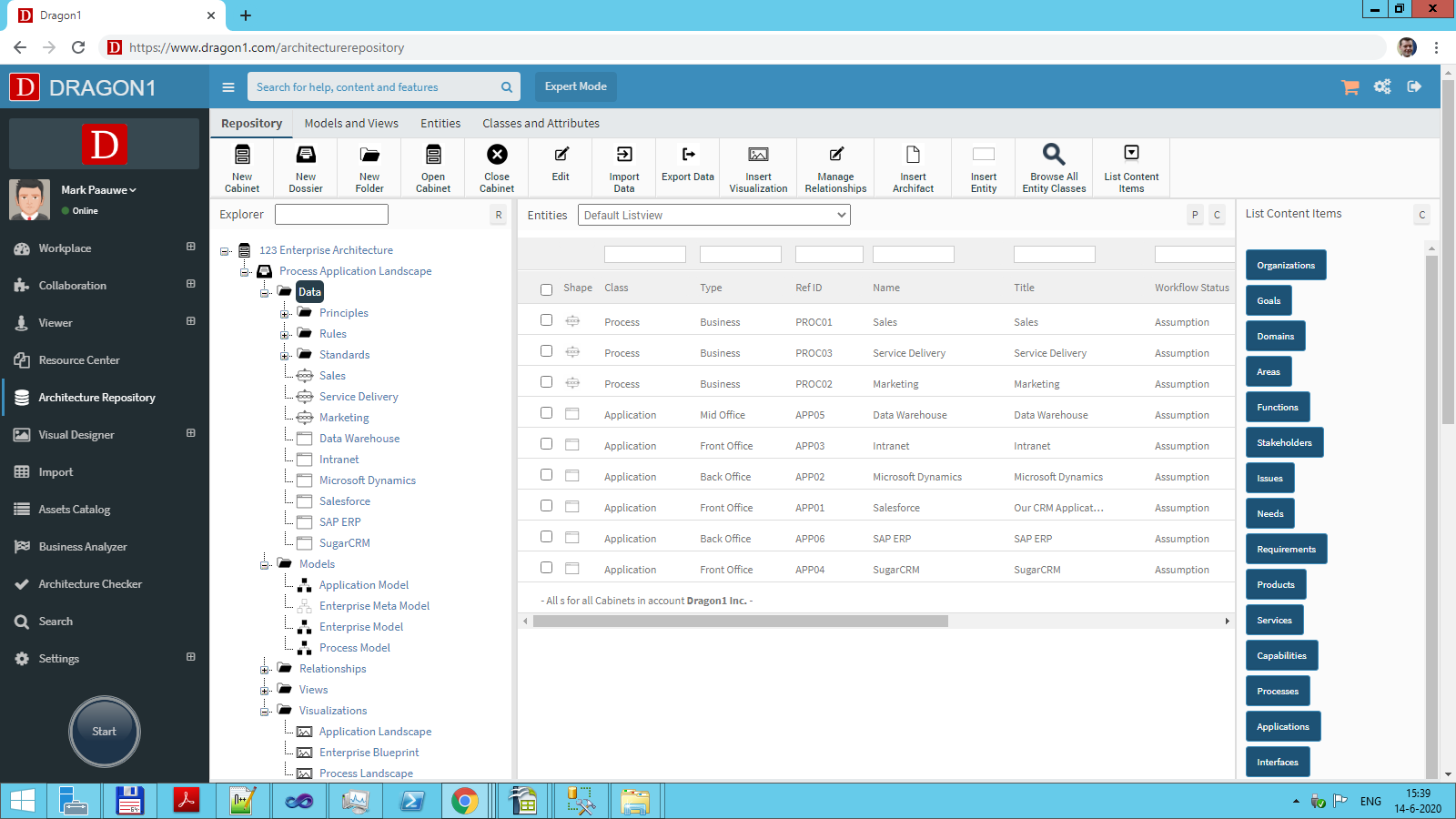Architecture Repository application
The Dragon1 platform has two applications for entry of data entities:

- Collaboration application (this page)
- Architecture Repository
Administration Application
The Architecture Repository, or CMDB, is a Dragon1 administration application for setting up and managing your architecture administration.
The Architecture Repository is a web application that allows you to administer data entities. You can relate the data entities to each other so they form a model. These models you will use to create views (filters) on and link to visualizations or templates in the Visual Designer.
To the data entities that you administer, you can attach metadata such as standard images, but also your attributes, and you can add default values for those attributes.
Cabinets, Dossiers and Folders
The data you enter in the Architecture Repository is logically organized in cabinets, dossiers, and folders. You can create as many cabinets as you need in your account. A cabinet can contain any number of dossiers, and a dossier can comprise any number of folders.
Here you can read more about Cabinets, Dossiers and Folders
To enter data, you will first create a cabinet, often with the name of your company, program, or project. Next, you will create dossiers in your cabinet, often on important topics within your organization, program, or project, like products, processes, changes, or solutions. Next, you will create folders in the dossiers. Folders often have names corresponding to types of dossier names.
Below, you see an example of a typical Cabinet-Dossier-Folder Structure. '123 Enterprise Architecture' is the Cabinet. 'Architecture Design Book' is a dossier. 'Models' is a folder. This folder has been selected, and its contents are in the middle.
You have access to databases for reference architectures, architectural designs, portfolios of architects and architectures, or the configuration of the enterprise itself. The meta-model of the database is modifiable.
Repository Meta Model
If you want to know how everything is connected in the repository, you can take a look here at the high-level overview of the Repository Meta Model
Forms and Fields
When you go to the Architecture Repository and select a cabinet, dossier, folder, or entity, you get a form presented. On this form, you can enter values in fields for a large set of attributes of the selected entity.
Here you can read all about the form fields you can enter per entity.
So if you administer an information system as an entity in the Architecture Repository, please indicate here which properties that information system possesses. Who is the owner, what business process is supported, who is the vendor, and is the information system part of a project? So, you can consider numerous data points. What data will be used, and who will determine it? This is undoubtedly defined in the architecture policy (that is published in the Resource Center).
Tasks
Here, we mention the main tasks you perform in the Repository.
1. Define and Administer Data Entities
Use the Repository to administer or import and organize the data entities you collect in the organization in any way you want.
2. Build Reusable Architecture Building Blocks
Use the Architecture Repository to build reusable building blocks and stacks of data entities.
3. Creating Models (Entity Relationships)
In the Architecture Repository, you relate the data entities that you have administered with each other, and with that, you create models. A model on Dragon1 is a set of relationships between data entities linked to a model entity
For instance, you will relate products to services, services to processes, and processes to applications on Dragon1. In this way, you create, in a short period, a model of the whole enterprise.
Later on, you will visualize stakeholder-oriented views in the Visual Designer using the data from the enterprise model.
On this page, you can read how to create relationships between data entities and with that create models.
4. Manage, make, and keep your data consistent
The Architecture Repository is the application to make and keep your data consistent. All the information you have written down in documents, you can keep consistent with the Architecture Repository.


